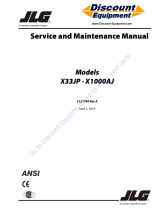
Page 10 Vertical Mast Series
Models SJ12 & SJ16
157981
Section 1 - Scheduled MaintenanceOperator’s Responsibility for Maintenance
Safety Precautions
Know and understand the safety precautions before going on to next section.
WARNING
Failure to heed the following safety
precautions could result in tip over,
falling, crushing, or other hazards leading
to death or serious injury.
• KNOW all national, state or territorial/provincial
and local rules which apply to your aerial platform
and job site.
• TURN main power disconnect switch “ ” off
when leaving the aerial platform unattended. Re-
move the key to prevent unauthorized use of the
aerial platform.
• WEAR all the protective clothing and personal
safety devices issued to you or called for by job
conditions.
• DO NOT wear loose clothing,
dangling neckties, scarves,
rings, wristwatches or other jew-
elry while operating this lift.
• AVOID entanglement with ropes,
cords or hoses.
• AVOID falling. Stay within the
boundaries of the guardrails.
• DO NOT raise the aerial platform
in windy or gusty conditions.
• DO NOT increase the lateral surface area of the
platform. Increasing the area
exposed to the wind will de-
crease aerial platform stability.
• DO NOT drive or elevate the
aerial platform if it is not on a
firm level surface. Do not drive
elevated near depressions
or holes of any type, loading
docks, debris, drop-offs and
surfaces that may affect the
stability of the aerial platform.
• If operation in areas with holes or drop-
offs is absolutely neces-
sary, elevated driving shall
not be allowed. Position the
aerial platform horizontally
only with the platform fully
lowered. After ensuring that
all 4 wheels or outriggers (if
equipped) have contact with
level firm surface, the aerial
platform can be elevated. Af-
ter elevation, the drive func-
tion must not be activated.
• Elevated driving must only
be done on a firm level sur-
face.
• DO NOT ascend or descend
a grade when elevated. When
fully lowered, ascending or
descending grades up to max-
imum rated inclines listed in
Table 2.3.
• DO NOT operate on surfaces
not capable of holding the
weight of the aerial platform including the rated
load, e.g., covers, drains, and trenches.





















